BACK TO BASICS
SOTAI-DOSA
'Exercises with a partner'
TACHI-WAZA KOKYU-HO
'Standing Breath-Dower Exercise'
Sokumen 側 面 (to the side)
|
|

Demonstrated and explained by Kanetsuka Sensei
Photos and text: Peter Megann
Graphics and typesetting: Graham and Laura Jones
Uke: Richard Martin
|
In order to understand the principles of 'Standing Breath-power Exercise" we shall first recall the important points of the 'Sitting Breath-power Exercise' (Suwari-waza Kokyu-ho)
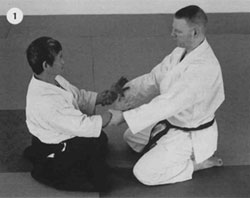
Photo 2: As you raise your arms, your hands make a circular movement, as though you are holding a large ball. With shoulders and elbows relaxed you open your hands. Your arms are neither quite straight nor bent.
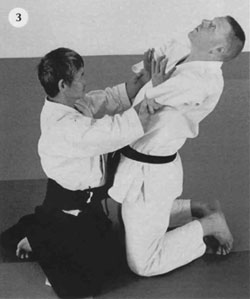
|
Photo 1: The most basic form of Kokyu-ho which we practice is Suwari-waza Kokyu-ho. Herein lie the most important elements of this Kokyu-ho. We begin from a very stable base: like a pyramid. Uke holds both of Tori's wrists. In this situation no tai-sabaki is possible. The point of contact (where you partner has hold of your wrists) rises, while keeping a feeling of thrusting towards your partner.
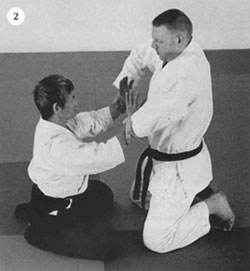
Photo 3: Your elbows move outwards as your arms come up. It's as though you are holding a sword in either hand, swinging them upwards, making good use of your wrists. All this must be accomplished smoothly, without jerking. As your hands are raised your thumbs point towards your own face.
This is also an exercise for Uke: through repeating Suwari-waza Kokyu-ho many times he learns how to hold Tori correctly. This should not be with a vice-like grip, but with a sensitive contact that involves the whole body. It's as though Uke is holding two swords pointing towards Tori's neck.
|
The basic principles which we learn from Suwari-waza Kokyu-ho will apply to all Aikido techniques: Ikkyo, Irimi-nage, Shiho-nage, Kokyu-nage, etc. And the important thing about Suwari-waza Kokyu-ho is that no tai-sabaki is possible until the moment when Tori cuts Uke down to the side and, pivoting on his knee, he follows Uke as he falls and controls him on the ground. It depends simply on how you swing your hands up and down.
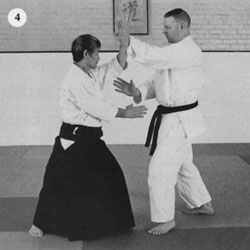
TACHI-WAZA KOKYU-HO
Photo 4: As Tori makes a strike at Uke's head with his left hand, Uke protects himself by intercepting the blow and bringing Tori's arm downwards. Both Tori and Uke must maintain good, solid contact by keeping a good upright, low posture and keeping the shoulders relaxed.
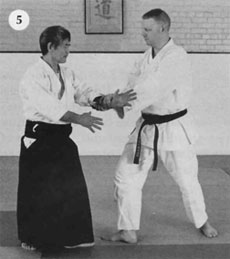 Photo 5: As Uke grasps Tori's left wrist with both his hands (morote-dori) he brings his right foot forward and steps off the attacking line, coming into gyaku-hanmi relationship with Tori.
Photo 5: As Uke grasps Tori's left wrist with both his hands (morote-dori) he brings his right foot forward and steps off the attacking line, coming into gyaku-hanmi relationship with Tori.
Both Tori's and Uke's kamae (stance) is as though holding a sword. It's important that Tori is not simply striking: there should be a feeling of tsuki (thrusting) also.
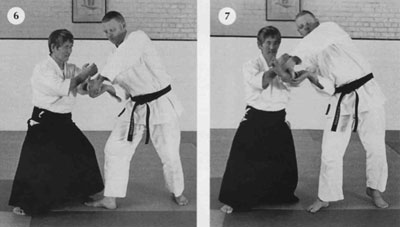 Photos 6 & 7: Maintaining this feeling of tsuki but without moving the point of contact (where Uke is holding). Tori slides his left foot to the side to avoid a possible attack from Uke (e.g. a kick). At the same time Tori lowers his hips and shifts his centre of gravity from right to left, changing direction. He finishes in what we call sokumen (sideways) relationship with Uke. For a moment he is parallel with Uke at an angle of about 90° to the original attacking line.
Photos 6 & 7: Maintaining this feeling of tsuki but without moving the point of contact (where Uke is holding). Tori slides his left foot to the side to avoid a possible attack from Uke (e.g. a kick). At the same time Tori lowers his hips and shifts his centre of gravity from right to left, changing direction. He finishes in what we call sokumen (sideways) relationship with Uke. For a moment he is parallel with Uke at an angle of about 90° to the original attacking line.
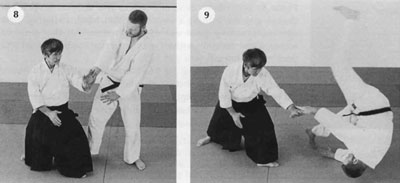 Photos 8 & 9: At this point Tori can continue with the usual kokyu-nage, throwing Uke to the rear (as in photos 10 -13); or after making tenkan to his right, he can step forwards with his left foot and project Uke forwards, as shown here.
Photos 8 & 9: At this point Tori can continue with the usual kokyu-nage, throwing Uke to the rear (as in photos 10 -13); or after making tenkan to his right, he can step forwards with his left foot and project Uke forwards, as shown here.
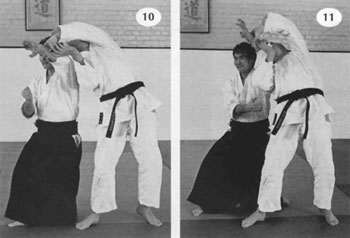 Photos 10 & 11: As Tori turns to his right, he lifts his left arm. The shoulder must be completely relaxed, just like a hinge. Except that we are lifting only one arm, all that was described in Suwari-waza Kokyu-ho applies here. The motion is like saluting. Keep a stable posture and don't shrink. Be careful not to twist your body as you raise your hand, and don't let the hand go beyond the line of your centre, that's to say the line between your navel and your nose; because once it passes this line you become weaker. If you propel your partner's centre ahead of his feet at this point and get him on his toes, it is much easier to take him off balance. The purpose of this movement is to avoid your partner's attack and in turn to attack him from the side. You should not break the contact but rather lead your partner.
Photos 10 & 11: As Tori turns to his right, he lifts his left arm. The shoulder must be completely relaxed, just like a hinge. Except that we are lifting only one arm, all that was described in Suwari-waza Kokyu-ho applies here. The motion is like saluting. Keep a stable posture and don't shrink. Be careful not to twist your body as you raise your hand, and don't let the hand go beyond the line of your centre, that's to say the line between your navel and your nose; because once it passes this line you become weaker. If you propel your partner's centre ahead of his feet at this point and get him on his toes, it is much easier to take him off balance. The purpose of this movement is to avoid your partner's attack and in turn to attack him from the side. You should not break the contact but rather lead your partner.
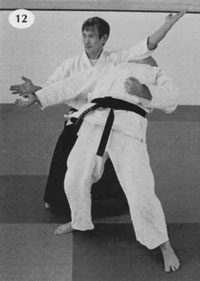 Photos 12 & 13: Keep a low posture as you continue the circular motion with
your left arm. Don't be in a hurry to throw your partner with a pushing
movement. You should first stretch your partner's back before you start moving
to your left. Throughout all this spherical movement you and your partner should
remain in harmony. When your partner is quite unbalanced, slide your left foot
Photos 12 & 13: Keep a low posture as you continue the circular motion with
your left arm. Don't be in a hurry to throw your partner with a pushing
movement. You should first stretch your partner's back before you start moving
to your left. Throughout all this spherical movement you and your partner should
remain in harmony. When your partner is quite unbalanced, slide your left foot
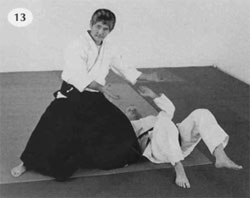 behind him and shift your weight onto your left foot (just as in the Tori-fune exercise). Your left arm
completes its circular movement; in fact it describes a complete circle from the moment of
first contact (photo 6). As your partner falls keep your right hand engaged in the movement (don't
leave it behind) and finish with Zanshin.
behind him and shift your weight onto your left foot (just as in the Tori-fune exercise). Your left arm
completes its circular movement; in fact it describes a complete circle from the moment of
first contact (photo 6). As your partner falls keep your right hand engaged in the movement (don't
leave it behind) and finish with Zanshin.
Application: Against Chudan Tsuki
With a tsuki attack the situation is more difficult than that above, since your partner is not gripping your wrist.
Photos 14 & 15: As Uke makes chudan tsuki. Tori steps to his left, off the attacking line. Tori's hands make a cutting movement directed toward's Uke's neck and shoulder. But this is not a case of blocking or of pushing Uke's arm. (Don't forget that the attacker might pull back his arm to strike again.) Tori's arms are very relaxed, simply acting as a shield. The feeling is like that of enveloping Uke's attacking arm.
Photos 16 & 17: The
movements of Tori's feet and body are just like those in photos 6 & 7.
Photos 18-20: Tori's movements are the same as in photos 10 - 13.
The principles of good stable stance, low centre of gravity, moving into a triangular relationship with your partner, your arms maintaining a circular movement, are all applied in these kokyu movements. And remember: don"t try to use strength, don't push. Even if you do these movements slowly they should work.


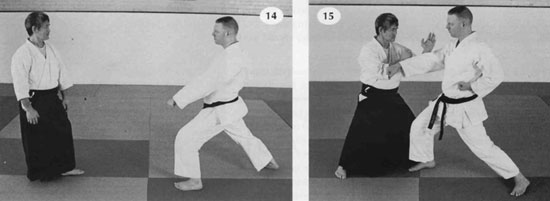
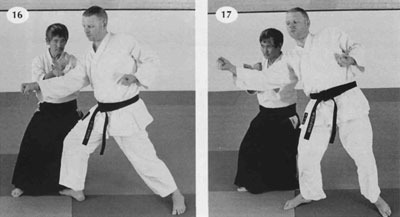
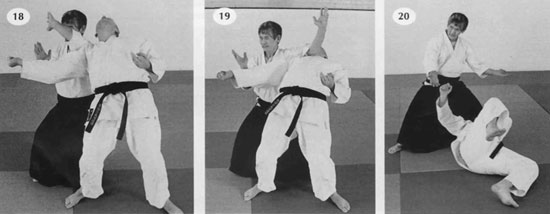
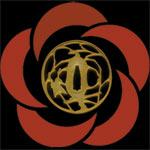



 Photo 5: As
Photo 5: As  Photos 6 & 7: Maintaining this feeling of
Photos 6 & 7: Maintaining this feeling of  Photos 8 & 9: At this point
Photos 8 & 9: At this point  Photos 10 & 11: As
Photos 10 & 11: As  Photos 12 & 13: Keep a low posture as you continue the circular motion with
your left arm. Don't be in a hurry to throw your partner with a pushing
movement. You should first stretch your partner's back before you start moving
to your left. Throughout all this spherical movement you and your partner should
remain in harmony. When your partner is quite unbalanced, slide your left foot
Photos 12 & 13: Keep a low posture as you continue the circular motion with
your left arm. Don't be in a hurry to throw your partner with a pushing
movement. You should first stretch your partner's back before you start moving
to your left. Throughout all this spherical movement you and your partner should
remain in harmony. When your partner is quite unbalanced, slide your left foot
 behind him and shift your weight onto your left foot (just as in the
behind him and shift your weight onto your left foot (just as in the